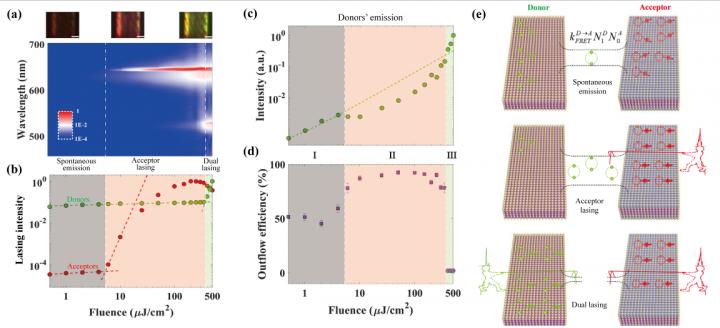
Credit: Junhong Yu, Manoj Sharma, Ashma Sharma, Savas Delikanli, Hilmi Volkan Demir, Cuong Dang
Exciton-based solid-state devices have the potential to be essential building blocks for modern information technology to slow down the end of Moore’s law. Exploiting excitonic devices requires the ability to control the excitonic properties (e.g., exciton flow, exciton recombination rates or exciton energy) in an active medium. However, until now, the demonstrated techniques for excitonic control have either been inherently complex or sacrificed the operation speed, which is self-defeating and impractical for actual implementation. Hence, a scheme with an emphasis on all-optical control, bottom-up fabrication and self-assembly is highly desired for real-world applications.
In a new paper published in Light Science & Applications, scientists from the School of Electrical & Electronic Engineering, Nanyang Technological University, Singapore, developed a convenient way to control exciton flow between different colloidal quantum wells (CQWs) at room temperature, all through optical signals. Through the combination of stimulated emission and Förster resonance energy transfer (FRET), the flow of excitons between donor Cadium selenide (CdSe) core-only CQWs and acceptor CdS/CdSe/CdS core-shell CQWs can be strongly manipulated. Using this method, continuous transition among three distinct exciton flow regimes with efficiencies of ~50%, ~90% and ~2% has been demonstrated. The reported method and technique, which demonstrate a lab-prototype of an all-optical controllable exciton flow device with multiple modulation stages, may inspire the design of all-optical excitonic circuits operating at room temperature.
The core idea of the method is based on the competition of stimulated emission rate, spontaneous emission rate and FRET rate together with the threshold behavior of stimulated emission. These scientists summarize the excitonic flow control process in their works:
“At low pump fluence when the emission of both donors and acceptors is spontaneous, nearly 50% of the exciton population in the donors outflows into the acceptors via FRET. By increasing the pumping level to achieve stimulated emission in the acceptors, we can greatly enhance the exciton flow efficiency up to 90% since quick depletion of excitons in the acceptors significantly promotes the FRET process. Upon further increasing the fluence to initiate stimulated emission in the donors, the exciton flow towards the acceptors almost switches off because the stimulated emission rate in donors is much faster than the FRET rate.”
“To get deeper insight into this process, we have developed a FRET-coupled kinetic model to identify the competing processes responsible for the manipulation of exciton flow at different level of optical excitation. The simulation results can qualitatively reproduce the exciton flow trend from the donors to the acceptors demonstrated in our experiments.” Junhong Yu, the first author of the research, added.
“This active excitonic control in an all-optical device (i.e., a whispering gallery mode laser configuration) not only offers a platform to gain deeper insight of the FRET physics but also is highly preferable for excitonic-based information processing with potentials of all-optical-control excitonic circuits.” Dr. Cuong Dang, the senior author of the research said.
“The authors discuss a very timely scientific challenge, which is to move towards the excitonic devices. Controlling the exciton flow in the optically active media is the essential requirement for the development of solid-state device, and thus, has been the center of attention. The use of population overlap modulated by the lasing action in the donor-acceptor pairs will be an interesting addition to the extension excitonic studies on optically active materials. This study has merits and the advance is technological, offering an all-optical route to manipulate exciton flow in colloidal quantum well structures.” Dr. Lei, one of the reviewer of LSA said.
###
Media Contact
Cuong Dang
[email protected]
Related Journal Article
http://dx.




